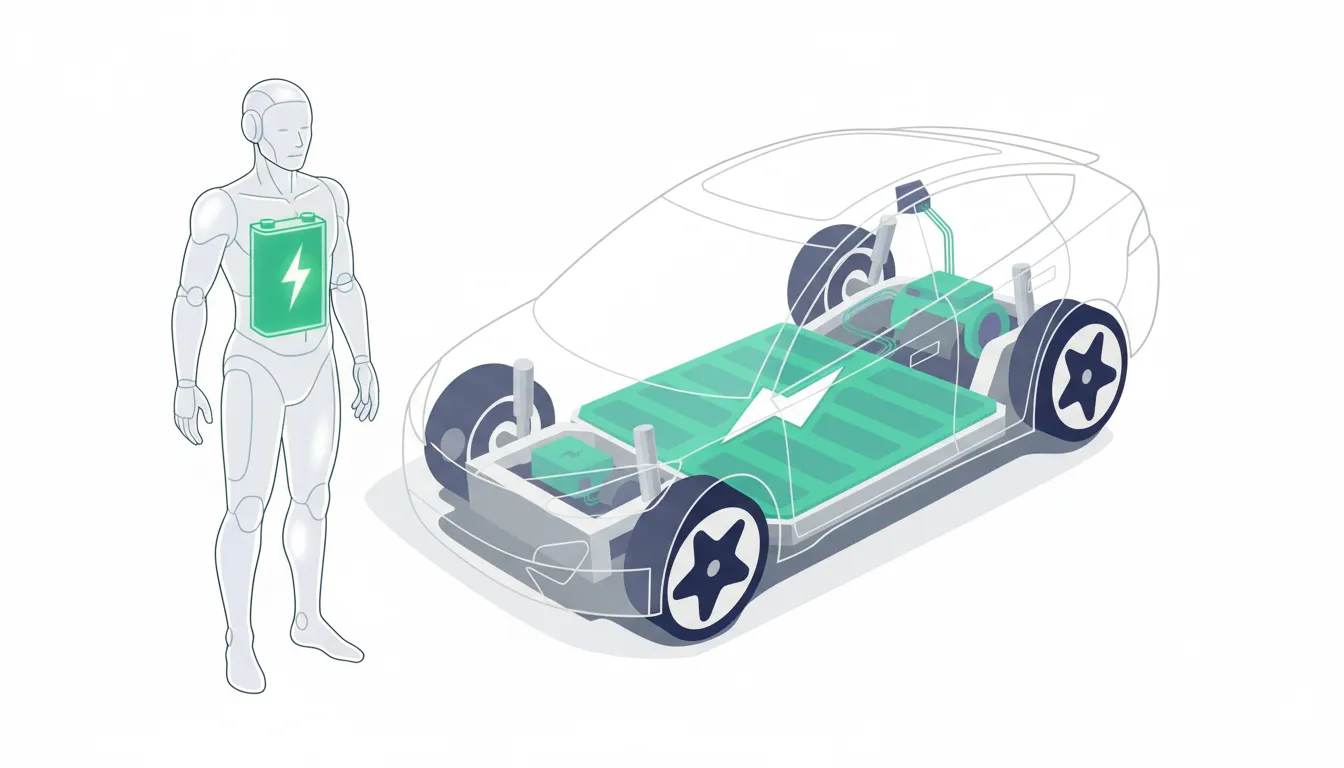- The single biggest constraint for humanoids and EVs is the Lithium-Ion (Li-ion) battery's limited energy density, which restricts robot runtime to 1–2 hours and caps EV range.
- Increasing battery capacity in EVs and robots is achieved by adding more individual cells, which exponentially increases the risk of thermal runaway propagation (a domino effect fire) due to the flammable liquid electrolyte.
- The Solid-State Battery (SSB) is the next generation, replacing the flammable liquid electrolyte with a solid material. This promises dramatically higher energy density (longer range/runtime) and virtually eliminates the risk of thermal runaway.
For decades, robotics has focused on the brain and agility, building AI sophisticated enough to see, think, adapt and react according to the various situation. But as these machines—from factory quadrupeds to human-like workers—move out of the lab and into the real world, a new truth has emerged: no matter how smart the brain, the body is useless without the energy to move it.
The single greatest constraint on the robot and electric vehicle revolution today is not only the software or computing power; it's the battery that operates.

The Robot's Dilemma: An Impossible Energy Budget
In the robotics industry, the energy problem is particularly acute. An Automated Guided Vehicle (AGC) in a warehouse has large, simple chassis to house a big battery, allowing it to run for 10-20 hours. But for a humanoid or a quadrupedal robot, the energy demands are impossibly high:
- Complexity: Unlike a wheeled vehicle, a bipedal or quadrupedal machine use powerful actuators to constantly correct its balance against gravity. Every step, every sudden movement, and every lift is massive, high-power draw.
- Compact Form: These robots must fit their power source into a compact, human-like frame, severely limiting the battery's size.
- Auxiliary System Drain: Beyond movement, critical non-movement tasks—the "overhead" of the robot—demand constant power, further draining the limited battery capacity:
- High-Performance Computing: The onboard compute units required to run the AI models for vision, path planning, and real-time control consume substantial energy. The more complex the environment and the faster the robot moves, the move "thinking" power the compute needs.
- Active Cooling Systems: Both the powerful actuators and the compute units generate immense heat. Robots must employ active cooling to manage this heat and prevent system shutdown. These cooling systems themselves require energy from the battery, creating a cycle where high-demand tasks generate heat, forcing the battery to power the cooling system, thus reducing the power available for movement.
The result? The norm for most advanced humanoids today is a runtime of only 1-2 hours of continuous, untethered operation. They spend more time charging than working, effectively keeping them caged in the lab—a situation that makes large-scale commercial deployment impossible.

The Reign of Lithium-Ion: Why it Dominates and Why it Fails
The energy heart powering almost all modern robotics and electric vehicles is the Lithium-Ion (Li-Ion) battery. It has reigned supreme for decades, from EVs to humanoids, not because it's perfect, but its performance is unmatched in one crucial area: Energy Density.
What is a Lithium-Ion Battery?
A Li-Ion battery is essentially a "rocking chair" of energy. It consists of three main parts:
- Anode: The negative electrode, often made out of graphite.
- Cathode: The positive electrode, made out of lithium compound
- Electrolyte (liquid): A flammable gel that allows the lithium ions to shuttle between the Anode and Cathode.
When you use the battery, lithium ions move through the liquid electrolyte from the Anode (-) to the Cathode (+), releasing electrons to power a device. When you charge, they move back.
Increasing the Capacity: The Scale and the Risk
For both EVs and humanoids, engineers must constantly seek more capacity. There are 2 primary ways to achieve this:
- Cell Chemistry Optimization: Manufacturers redesign the anode or the cathode to pack more lithium ions into the same space. This increase the Energy Density of a single cell, but is subject to physical and chemical limits.
- Pack Size Increase: Most capacity gains come from simply adding more individual cells and connecting them in parallel to form a larger battery pack.
The Catastrophic Trade-Off
While increasing the size and number of cells boosts range, it exponentially increases the risk of a catastrophic event known as thermal runaway. This is why EV fires are notoriously difficult to control and extinguish.
- Penetration and Deformation: In a severe crash, the battery pack's enclosure can be breached. A sharp object, even as small as a nail or the deformation of the cell itself can pierce the thin separator layer between the anode and cathode.
- Internal Short Circuit: This breach causes an immediate internal short circuit. The vast amount of energy stored in the cell is released instantly as heat.
- Thermal Runaway: This localized heat spike rapidly raises the temperature of the liquid electrolyte to the point of ignition. Because the cells are tightly packed, the intense heat quickly triggers its neighboring cells into the same state—a domino effect known as thermal runaway propagation.
- Firefighters' Challenge: Unlike a gasoline fire, which is extinguished by cutting off oxygen or cooling, a Li-Ion fire is sustained by the battery's internal chemistry. The thermal runaway process generates its own oxygen and requires massive volumes of water applied for long periods to cool the entire pack below the ignition threshold and stop the propagation.
The Next Frontier: Solid-State Battery (SSB)
The SSB fundamentally solves the Li-Ion safety problem by replacing the flammable liquid electrolyte with a solid material such as ceramics, glass or solid polymers. This simple change unlocks a massive potential:
- Zero Thermal Runway: The solid structure virtually eliminates the fire risk, making it far safer for passenger vehicles and for robots operating near people in homes and offices.
- Higher Density: The solid electrolyte allows the use of a pure lithium metal anode, which can dramatically increase energy density, translating to longer EV range and robot runtime without added weight.

XPENG IRON: The Solid-State Pioneer
While major EV manufacturers like Toyota and Volkswagen are racing to commercialize SSBs for cars, Chinese EV maker XPENG claimed to be the first in the world to deploy the technology in a humanoid robot.
At the XPENG 2025 AI Day, CEO, He XiaoPeng unveiled its next-generation IRON humanoid robot, stating that it is the "industry's first humanoid robot to use a full-solid-state battery". This new feature decrease a 30% of the overall weight and has increase a 30% battery capacity. IRON is able to withstand a 250°C environment, a 300 G direct impact and 3 mm penetration without causing a fire hazard.
%20XPENG%202025%20AI%20Day_%20Emergence%20-%20YouTube%20-%2075_58.webp)
The company justifies this aggressive move by arguing that the stringent safety requirements for a device operating in the home or office, where fire risk is unacceptable, making the humanoid the ideal platform to debut the safer, higher-density technology.
The Roadblocks Ahead: Is the Solid-State Dream Real?
Despite the immense promise of higher energy density and superior safety, Solid-State Batteries remain an elusive target for mass production, leading to questions about when or if they will truly materialize. After years of major investments by automotive and tech giants, engineers are still struggling with fundamental challenges: Will the new solid electrolytes prove robust enough to withstand the stresses of daily charging without breaking down? Specifically, the formation of microscopic, sharp growths known as dendrites during charging is major headache, as these spikes can crack the brittle solid layer, causing internal shorts and severely reducing the battery's lifespan.
Furthermore, manufacturing SSBs remains prohibitively expensive and difficult to scale up to massive volumes needed for global EV and robotics demand, causing doubt on whether the cost savings will ever outweigh the complexity of production.
In the meantime, companies have found a pragmatic solution to maximize operational time: autonomous battery swapping. Humanoids like AEON from Hexagon Robotics and the Walker S2 from UBTECH are designed to swap their own drained batteries for fully charged ones at a docking station, reducing downtime from hours to mere minutes. This mechanical workaround is the current stopgap to the energy bottleneck until the solid-state chemistry is perfected and made commercially viable
The future of autonomous vehicles and physical AI rests on unlocking this energy density. Until the solid-state battery can move from the lab to mass production, the world's most intelligent machines will continue to operate on a tight lithium-ion budget.




